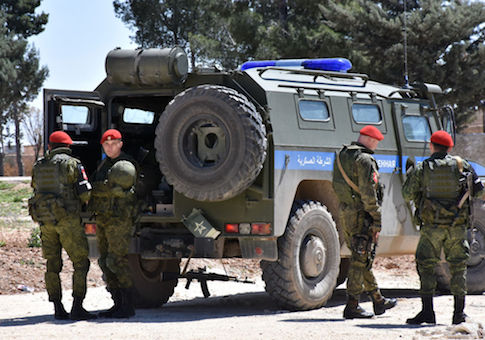Russia is playing a major and active role in covering up a serious chemical weapons strike in Syria that was planned by the regime of embattled President Bashar al-Assad, according to senior White House officials, who declassified a wide-range of intelligence on Tuesday that shows Moscow is waging an information campaign meant to undermine allegations Assad orchestrated the chemical weapons attack.
Russian forces were found to be working with Syrian regime military at the Shayrat airfield in the days and hours before the chemical weapons strike, according to the officials who spoke to reporters Tuesday afternoon only on background.
The U.S. officials questioned how it is possible that Moscow could not have been aware of the chemical weapons preparation in advance, but did not offer any conclusive information directly tying Russia to the strike.
Accusations by the United States that Russia is attempting to cover up the use of chemical weapons by Assad’s regime are likely to ratchet up tensions in the war torn country and further divide Washington and Moscow.
"I think it's clear the Russians are trying to cover up what happened there," said one senior White House official, who described an active "cover-up" by Russia meant to obfuscate "Syrian regime culpability" in the attack.
"The cover up is the disinformation since the day of the attack," the official said, declining to comment further on whether Russia had direct knowledge of the attack before it took place.
Russian and Syrian forces have been closely working together at the regime-controlled Shayrat airbase for more than two years now. The U.S. intelligence community had determined that Syrian operatives had been using the base as a site to prepare chemical weapons prior to the attack, which is said to have injured hundreds, including children.
"We do think it is a question worth asking the Russians: How is it possible their forces were collocated with the Syrian forces that planned and carried out a chemical weapons attack at the same installation and did not have foreknowledge," said one of the senior White House officials who brief reporters.
Russia has claimed that Syrian forces bombed a munitions depot belonging to anti-Assad terrorist forces. That strike, they claim, hit a chemical weapons storage facility belonging to these terrorists.
U.S. officials disclosed that intelligence confirms this narrative is false and improbable. Terrorist forces in that region to not possess chemical weapons like sarin gas, which was used in the most recent attack.
The U.S intelligence community also has no indication that ISIS or other terrorist forces in Syria are in possession of sarin chemicals. However, the Syrian regime has used this weapon in the past.
"We do not asses and have not assessed that any terrorists or ISIS in the area have sarin," said one of the senior U.S. officials. "It is quite clear to us this is not a terrorist holding of sarin or use of sarin. But we do know the Syrian regime has sarin and used it in the 2013 attack."
The Syrian regime "has not fully come clean" about the locations, facilities, agents, and personnel sponsoring the chemical weapons program.
"It’s a clear pattern of deflecting blame," the official said, referring to Russia's efforts to defend Assad and push a false narrative about the attack.
U.S. intelligence officials have confirmed that the chemical attack was carried out by "regime controlled" aircraft, which spent about 20 minutes dropping the chemical weapons.
"We have information that suggests that [Syrian] personnel historically associated with the chemical weapons program" were at Shayrat airbase in late March and again present at that airfield during attack.
The United States also has obtained physical samples from victims that are "consistent with nerve agent and sarin exposure," according to the official.
The United States is still investigating whether Russia had prior knowledge of the attack or participated in any manner. It is also investigating allegations that Assad is covering up separate chemical weapons sites inside Syria.
